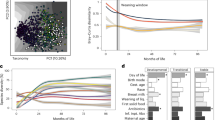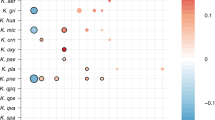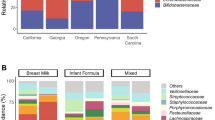Abstract
The potentially critical stage of initial gut colonization in premature infants occurs in the hospital environment, where infants are exposed to a variety of hospital-associated bacteria. Because few studies of microbial communities are strain-resolved, we know little about the extent to which specific strains persist in the hospital environment and disperse among infants. To study this, we compared 304 near-complete genomes reconstructed from fecal samples of 21 infants hospitalized in the same intensive care unit in two cohorts, over 3 years apart. The genomes represent 159 distinct bacterial strains, only 14 of which occurred in multiple infants. Enterococcus faecalis and Staphylococcus epidermidis, common infant gut colonists, exhibit diversity comparable to that of reference strains, inline with introduction of strains from infant-specific sources rather than a hospital strain pool. Unlike other infants, a pair of sibling infants shared multiple strains, even after extensive antibiotic administration, suggesting overlapping strain-sources and/or genetic selection drive microbiota similarities. Interestingly, however, five strains were detected in infants hospitalized three years apart. Three of these were also detected in multiple infants in the same year. This finding of a few widely dispersed and persistent bacterial colonizers despite overall low potential for strain dispersal among infants has implications for understanding and directing healthy colonization.
Similar content being viewed by others
Log in or create a free account to read this content
Gain free access to this article, as well as selected content from this journal and more on nature.com
or
References
Aagaard K, Ma J, Antony KM, Ganu R, Petrosino J, Versalovic J . (2014). The placenta harbors a unique microbiome. Sci Transl Med 6: 237ra65–237ra65.
Arboleya S, Binetti A, Salazar N, Fernández N, Solís G, Hernández-Barranco A et al. (2012). Establishment and development of intestinal microbiota in preterm neonates. FEMS Microbiol Ecol 79: 763–772.
Arrieta M-C, Stiemsma LT, Amenyogbe N, Brown EM, Finlay B . (2014). The intestinal microbiome in early life: health and disease. Front Immunol 5: e-pub ahead of print, doi: 10.3389/fimmu.2014.00427.
Aujoulat F, Roudière L, Picaud J-C, Jacquot A, Filleron A, Neveu D et al. (2014). Temporal dynamics of the very premature infant gut dominant microbiota. BMC Microbiol 14: 2320.
Barrett E, Kerr C, Murphy K, O’Sullivan O, Ryan CA, Dempsey EM et al. (2013). The individual-specific and diverse nature of the preterm infant microbiota. Arch Dis Child Fetal Neonatal Ed 98: F334–F340.
Brooks B, Firek BA, Miller CS, Sharon I, Thomas BC, Baker R et al. (2014). Microbes in the neonatal intensive care unit resemble those found in the gut of premature infants. Microbiome 2: 1.
Brown CT, Sharon I, Thomas BC, Castelle CJ, Morowitz MJ, Banfield JF . (2013). Genome resolved analysis of a premature infant gut microbial community reveals a Varibaculum cambriense genome and a shift towards fermentation-based metabolism during the third week of life. Microbiome 1: 30.
Carlisle EM, Morowitz MJ . (2013). The intestinal microbiome and necrotizing enterocolitis. Curr Opin Pediatr 25: 382–387.
Chin C-S, Sorenson J, Harris JB, Robins WP, Charles RC, Jean-Charles RR et al. (2010). The origin of the haitian cholera outbreak strain. N Engl J Med 364: 33–42.
Costello EK, Carlisle EM, Bik EM, Morowitz MJ, Relman DA . (2013). Microbiome assembly across multiple body sites in low-birthweight infants. MBio 4: e00782–13.
De la Cochetiere M-F, Piloquet H, des Robert C, Darmaun D, Galmiche J-P, Roze J-C . (2004). Early intestinal bacterial colonization and necrotizing enterocolitis in premature infants: the putative role of Clostridium. Pediatr Res 56: 366–370.
Deatherage DE, Barrick JE . (2014). Identification of mutations in laboratory-evolved microbes from next-generation sequencing data using breseq. Methods Mol Biol 1151: 165–188.
Delcher AL, Phillippy A, Carlton J, Salzberg SL . (2002). Fast algorithms for large-scale genome alignment and comparison. Nucleic Acids Res 30: 2478–2483.
Dick GJ, Andersson AF, Baker BJ, Simmons SL, Thomas BC, Yelton AP et al. (2009). Community-wide analysis of microbial genome sequence signatures. Genome Biol 10: R85.
Edgar RC . (2010). Search and clustering orders of magnitude faster than BLAST. Bioinformatics 26: 2460–2461.
Fossum S, Crooke E, Skarstad K . (2007). Organization of sister origins and replisomes during multifork DNA replication in Escherichia coli. EMBO J 26: 4514–4522.
Funkhouser LJ, Bordenstein SR . (2013). Mom knows best: the universality of maternal microbial transmission. PLoS Biol 11: e1001631.
Groer MW, Luciano AA, Dishaw LJ, Ashmeade TL, Miller E, Gilbert JA . (2014). Development of the preterm infant gut microbiome: a research priority. Microbiome 2: 38.
Guttman D, Dykhuizen D . (1994). Clonal divergence in Escherichia coli as a result of recombination, not mutation. Science 266: 1380–1383.
He M, Miyajima F, Roberts P, Ellison L, Pickard DJ, Martin MJ et al. (2013). Emergence and global spread of epidemic healthcare-associated Clostridium difficile. Nat Genet 45: 109–113.
Hendricks CW . (1972). Enteric bacterial growth rates in river water. Appl Microbiol 24: 168–174.
Hyatt D, Chen G-L, Locascio PF, Land ML, Larimer FW, Hauser LJ . (2010). Prodigal: prokaryotic gene recognition and translation initiation site identification. BMC Bioinformatics 11: 119.
Joshi N, Fass J . (2011), Sickle: a sliding-window, adaptive, quality-based trimming tool for FastQ files (Version 1.29) [Software].
Kanehisa M, Goto S, Sato Y, Kawashima M, Furumichi M, Tanabe M . (2014). Data, information, knowledge and principle: back to metabolism in KEGG. Nucleic Acids Res 42: D199–D205.
Köser CU, Holden MTG, Ellington MJ, Cartwright EJP, Brown NM, Ogilvy-Stuart AL et al. (2012). Rapid whole-genome sequencing for investigation of a neonatal MRSA outbreak. N Engl J Med 366: 2267–2275.
La Rosa PS, Warner BB, Zhou Y, Weinstock GM, Sodergren E, Hall-Moore CM et al. (2014). Patterned progression of bacterial populations in the premature infant gut. Proc Natl Acad Sci 111: 12522–12527.
Langmead B, Salzberg SL . (2012). Fast gapped-read alignment with Bowtie 2. Nat Methods 9: 357–359.
Lee H, Popodi E, Tang H, Foster PL . (2012). Rate and molecular spectrum of spontaneous mutations in the bacterium Escherichia coli as determined by whole-genome sequencing. Proc Natl Acad Sci USA 109: E2774–E2783.
Leinonen R, Diez FG, Binns D, Fleischmann W, Lopez R, Apweiler R . (2004). UniProt archive. Bioinformatics 20: 3236–3237.
Loman N, Constantinidou C, Christner M, Rohde H, Chan JZ, Quick J et al. (2013). A culture-independent sequence-based metagenomics approach to the investigation of an outbreak of shiga-toxigenic escherichia coli o104:h4. JAMA 309: 1502–1510.
Lowe TM, Eddy SR . (1997). tRNAscan-SE: a program for improved detection of transfer RNA genes in genomic sequence. Nucleic Acids Res 25: 0955–0964.
Macdorman MF, Declercq E, Mathews TJ . (2013). Recent trends in out-of-hospital births in the United States. J Midwifery Women’s Heal 58: 494–501.
Magne F, Abély M, Boyer F, Morville P, Pochart P, Suau A . (2006). Low species diversity and high interindividual variability in faeces of preterm infants as revealed by sequences of 16S rRNA genes and PCR-temporal temperature gradient gel electrophoresis profiles. FEMS Microbiol Ecol 57: 128–138.
Markowitz VM, Chen I-MA, Palaniappan K, Chu K, Szeto E, Pillay M et al. (2014). IMG 4 version of the integrated microbial genomes comparative analysis system. Nucleic Acids Res 42: D560–D567.
McArthur AG, Waglechner N, Nizam F, Yan A, Azad MA, Baylay AJ et al. (2013). The comprehensive antibiotic resistance database. Antimicrob Agents Chemother 57: 3348–3357.
Moles L, Gómez M, Heilig H, Bustos G, Fuentes S, de Vos W et al. (2013). Bacterial diversity in meconium of preterm neonates and evolution of their fecal microbiota during the first month of life. PLoS One 8: e66986.
Moran NA, McLaughlin HJ, Sorek R . (2009). The dynamics and time scale of ongoing genomic erosion in symbiotic bacteria. Science 323: 379–382.
Morowitz MJ, Denef VJ, Costello EK, Thomas BC, Poroyko V, Relman DA et al. (2011). Strain-resolved community genomic analysis of gut microbial colonization in a premature infant. Proc Natl Acad Sci USA 108: 1128–1133.
Morrow AL, Lagomarcino AJ, Schibler KR, Taft DH, Yu Z, Wang B et al. (2013). Early microbial and metabolomic signatures predict later onset of necrotizing enterocolitis in preterm infants. Microbiome 1: 13.
Nawrocki EP, Eddy SR . (2013). Infernal 1.1: 100-fold faster RNA homology searches. Bioinformatics 29: 2933–2935.
Neu J, Walker WA . (2011). Necrotizing enterocolitis. N Engl J Med 364: 255–264.
Peng Y, Leung HCM, Yiu SM, Chin FYL . (2012). IDBA-UD: a de novo assembler for single-cell and metagenomic sequencing data with highly uneven depth. Bioinformatics 28: 1420–1428.
Raveh-Sadka T, Thomas BC, Singh A, Firek B, Brooks B, Castelle CJ et al. (2015). Gut bacteria are rarely shared by co-hospitalized premature infants, regardless of necrotizing enterocolitis development. Elife; e-pub ahead of print 3 March 2015; doi:10.7554/eLife.05477.
Schnabl K-L, Van Aerde J-E, Thomson A-B, Clandinin M-T . (2008). Necrotizing enterocolitis: a multifactorial disease with no cure. World J Gastroenterol 14: q2142–2161.
Sha1ron I, Morowitz MJ, Thomas BC, Costello EK, Relman DA, Banfield JF . (2013). Time series community genomics analysis reveals rapid shifts in bacterial species, strains, and phage during infant gut colonization. Genome Res 23: 111–120.
Sim K, Shaw AG, Randell P, Cox MJ, McClure ZE, Li M-S et al. (2015). Dysbiosis anticipating necrotizing enterocolitis in very premature infants. Clin Infect Dis 60: 389–397.
Snitkin ES, Zelazny AM, Thomas PJ, Stock F, Henderson DK, Palmore TN et al. (2012). Tracking a hospital outbreak of carbapenem-resistant Klebsiella pneumoniae with whole-genome sequencing. Sci Transl Med 4: 148ra116.
Sommer DD, Delcher AL, Salzberg SL, Pop M . (2007). Minimus: a fast, lightweight genome assembler. BMC Bioinformatics 8: 64.
Ultsch A, Moerchen F . (2005). ESOM-Maps: tools for clustering, visualization, and classification with Emergent SOM. Tech Rep Dep Math Comput Sci Univ Marburg, Ger 46.
Wang Y, Hoenig JD, Malin KJ, Qamar S, Petrof EO, Sun J et al. (2009). 16S rRNA gene-based analysis of fecal microbiota from preterm infants with and without necrotizing enterocolitis. ISME J 3: 944–954.
Zerbino DR, Birney E . (2008). Velvet: algorithms for de novo short read assembly using de Bruijn graphs. Genome Res 18: 821–829.
Zhou Y, Shan G, Sodergren E, Weinstock G, Walker WA, Gregory KE . (2015). Longitudinal analysis of the premature infant intestinal microbiome prior to necrotizing enterocolitis: a case-control study. PLoS One 10: e0118632.
Acknowledgements
This work was supported by NIH Grant 5R01AI092531, a Sloan foundation grant APSF-2012-10-05 and an EMBO long-term fellowship (to TRS and IS). ggKbase was supported by DOE grants DE-SC0004918 and ER65561. We thank Andrea Singh for assistance with ggKbase and Elizabeth Costello for insights from 16S rRNA-sequencing data.
Author information
Authors and Affiliations
Corresponding author
Ethics declarations
Competing interests
The authors declare no conflict of interest.
Additional information
Supplementary Information accompanies this paper on The ISME Journal website
Supplementary information
Rights and permissions
About this article
Cite this article
Raveh-Sadka, T., Firek, B., Sharon, I. et al. Evidence for persistent and shared bacterial strains against a background of largely unique gut colonization in hospitalized premature infants. ISME J 10, 2817–2830 (2016). https://doi.org/10.1038/ismej.2016.83
Received:
Revised:
Accepted:
Published:
Issue date:
DOI: https://doi.org/10.1038/ismej.2016.83
This article is cited by
-
Intravenous antibiotics in preterm infants have a negative effect upon microbiome development throughout preterm life
Gut Pathogens (2023)
-
Capturing the antibiotic resistome of preterm infants reveals new benefits of probiotic supplementation
Microbiome (2022)
-
An improved workflow for accurate and robust healthcare environmental surveillance using metagenomics
Microbiome (2022)
-
Rapid methicillin resistance diversification in Staphylococcus epidermidis colonizing human neonates
Nature Communications (2021)
-
Embracing microbes in exposure science
Journal of Exposure Science & Environmental Epidemiology (2019)



